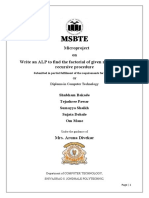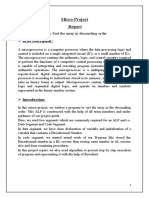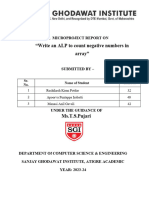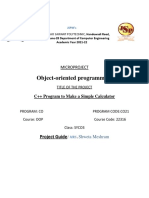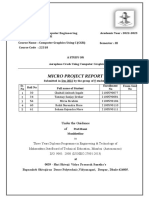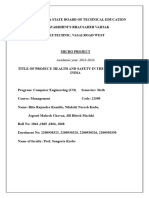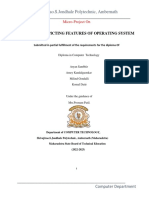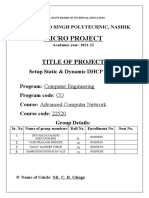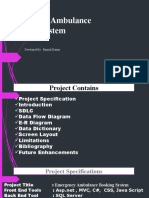0 ratings0% found this document useful (0 votes) 242 views8 pagesMicroprocessor
Copyright
© © All Rights Reserved
We take content rights seriously. If you suspect this is your content,
claim it here.
Available Formats
Download as PDF or read online on Scribd
Microprocessor Course Code: 22415
ProgramName: Computer Engineering Program Group / Diploma in Artificial
Intelligence and Machine Learning,
Program Code : COICM/ICWIAN
Semester : Fourth
Course Title : Microprocessor
Course Code 222415,
1, RATIONALE
Microprocessor is the main component of computer where 8086 is the base of all upward
developed processors till current processors. This course will cover the basics of 8086 and its
architecture along with instruction set, assembly language programming with effective use of
procedure and macros. This course also covers the architectural issues such as instruction set
program and data types. On top that, the students are also introduced to the increasingly
important area of parallel organization. This subject serves as a basic to develop hardware
related projects. This course will enable the students to inculcate assembly language
programming concepts and methodology to solve problems.
2, COMPETENCY
‘The aim of this course is to help the student to attain the following industry identified
competency through various teaching learning experiences:
* Develop assembly level language programming using 8086.
3. COURSE OUTCOMES (COs)
‘The theory, practical experiences and relevant soft skills associated with this course are to be
taught and implemented, so that the student demonstrates the following industry oriented
COs associated with the above mentioned competency:
‘Analyze the functional block of 8086 microprocessor.
Write assembly language program for the given problem.
Use instructions for different addressing modes.
Develop an assembly language program using assembler.
Develop assembly language programs using procedures, macros and modular
programming approach.
epese
4. TEACHING AND EXAMINATION SCHEME,
Teaching 7 —=
San | Examination Scheme
Creat heory Practical
ula p [OT Peper |_ESE PA Total ESE PA. Total
Hrs, [Max [Min | Max [Min | Max | Min[ Max [ Min | Max | Min | Max | Min
4{-|2 [6 | 3 | 7 [28 [30° [oo | t00 [40 | 25@ | 10 | 25 [ 10 | so | 20
(*): Under the theory PA; Out of 30 marks, 10 marks of theory PA are for micro-project
assessment to facilitate integration of COs and the remaining 20 marks is the average of 2
tests 10 be taken during the semester for the assessment of the UOs required for the
attainment of the COs.
MSBTE- Fi
Copy Dt. 10.01.2023, Page tof 8�Microprocessor Course Code: 22415
Legends: L-Lecture; T ~ Tutorial/Teacher Guided Theory Practice; P - Practical; C ~ Credit,
ESE - End Semester Examination; PA - Progressive Assessment, ‘#’: No Theory
Examination
5. COURSE MAP(with sample COs, PrOs, UOs, ADOs and topics)
‘This course map illustrates an overview of the flow and linkages of the topics at various levels
of outcomes (details in subsequent sections) to be attained by the student by the end of the
course, in all domains of learning ini terms of the industry/employer identified competency
depicted at the centre of this map. ~
E10 Wop ssn
eon a
os
Cetra)
=
CRED y
A momierteere
-
4 saitlegetpacaet
LoS eet
Figure 1 - Course Map
6. SUGGESTED PRACTICALS/ EXERCISES:
‘The practicals in this section are PrOs (i.e. sub-components of the COs) to be developed and
assessed in the student for the attainment of the competency.
Practical Outcomes (PrOs)
rious pins of the given microprocessor.
2 Use Assembly Language Programming Tools and functions
MSBTE — Final Copy Dt. 10.01.2023, Page 2 of 8�Microprocessor
Course Code: 22415
Practical Outcomes (PrOs)
Approx.
i
Required
Unit
No.
‘Use different addressing mode instruction in program
(a) Write an Assembly Language Program (ALP) to add two given
8 and 16 bit numbers.
((b) Write an Assembly Language Program (ALP) to subtract two
given 8 and 16 bit numbers.
Ml o2*
(@) Write an ALP to multiply two given 8 and 16 bit unsigned
numbers. "
(b) Write an ALP to multiply two given 8 and 16 bit signed
numbers.
Ml 02
(@) Write an ALP to perform block transfer data using string
instruetions
(b) Write an ALP to perform block transfer data without using
string instruetions
Mt 02
(@ Write an ALP to compare two strings without using string
instructions.
(b) Write an ALP to compare two strings using string instructions
UL 02
(a) Write an ALP to divide two unsigned numbers
|(b) Write an ALP to divide two signed numbers
vite 02
Write an ALP to add, subtract, multiply, divide two BCD
numbers.
IV 02
Implement loop in assembly language program
(a) Write an ALP to find sum of series of Hexadecimal Numbers.
(b) Write an ALP to find sum of series of BCD numbers.
Vv o2*
10
(@) Write an ALP to find smallest number from array of n
numbers,
(b) Write an ALP to find largest number from array of n numbers,
Iv 02*
ul
(a) Write an ALP to arrange numbers in array in ascending order.
(b) Write an ALP to arrange numbers in array in descending
order.
Iv 02
12
(a) Write an ALP to arrange string in reverse order
(b) Write an ALP to find string length.
(©) Write an ALP to concatenation of two strings.
IV 02
13
4
(a) Write an ALP to check a given number is ODD or EVEN.
(b) Write an ALP to count ODD and/or EVEN numbers in array.
Vv 02
(a) Write an ALP to check a given number is POSITIVE or
NEGATIVE
(b)Write an ALP to count POSITIVE and/or NEGATIVE numbers
in array,
IV 02
15
| (a) Write an ALP to count number of “I” in a given number
(b) Write an ALP to count number of “0” ina given number
‘An assembly language program using procedures
(a) Write an ALP for addition, subtraction, multiplication and
division
(b) Write an ALP using procedure to solve equation such as Z =
(A+B)*(C+D)
7
MSBTE — Final Copy Dt. 10.01.2023
Write an assembly language program using macros
Page 3 of 8�Microprocessor Course Code: 22415
at | APPFox.
s. : Unit
Fa Practical Outcomes (PrOs) New| Hrs.
(@) Write an ALP for addition, subtraction, multiplication and
division.
(b) Write an ALP using MACRO to solve equation such as 012, =
| rpy(crp)
Total 34
Note
i. A suggestive list of PrOs is given in the above table. More such PrOs can be added 10
attain the COs and competency. A judicial mix of minimum 24 or more practical need to be
performed, out of which, the practicals marked as '*” are compulsory, so that the student
reaches the ‘Precision Level’ of Dave's ‘Psychomotor Domain Taxonomy’ as generally
required by the industry.
ji, The ‘Process’ and ‘Product’ related skills associated with each PrO is to be assessed
according to a suggested sample given below:
S.No. Performance Indicators ae
1 | Able to write algorithm and draw flow chart. 20
‘Use Assembly language programming tools to create, edit, assemble |
and link the assembly language programs, 2
Debug, test and execute the programs 20 |
Able fo answer oral questions. 10 |
‘Submission of report in time. 10
- Total! 100
‘The above PrOs also comprise of the following social skills/attitudes which are Affective
Domain Outcomes (ADOs) that are best developed through the laboratory/field based
experiences:
a. Follow safety practices.
b. Practice good housekeeping.
c. Demonstrate working as a leader/a team member.
4. Follow ethical practices.
‘The ADOs are not specific to any one PrO, but are embedded in many PrOs, Hence, the
acquisition of the ADOs takes place gradually in the student when s/he undertakes a series of
practical experiences over a period of time. Moreover, the level of achievement of the ADOs
according to Krathwohl’s ‘Affective Domain Taxonomy” should gradually increase as planned
belo
+ ‘Valuing Level” in 1* year
* ‘Organizing Level’ in 2! year and
* ‘Characterizing Level” in 3" year.
7. MAJOR EQUIPMENT/ INSTRUMENTS REQUIRED
‘The major equipment with broad specification mentioned here will usher in nile
conduct of experiments, as well as aid to procure equipment by authorities con
MSBTE — Final Copy Dt, 10.01.2023 Page 4 of 8�Microprocessor
Course Code: 22415
2. | Operating system: Windows XP/Windows 7 onward
3 | Software: Editor: EDIT, NOTEPAD,
Assembler: TASM/MASM
Linker: TLINK/LINK
Debugger: _TD/Debug of Windows Operating System
x Equipment Name with Broad Specifications PrpesiNei
1 | Hardware: Personal computer, (3-15 preferable), RAM minimum 2GB | For all
onwards Experiments
8. UNDERPINNING THEORY COMPONENTS
The following topics are to be taught and assessed
below for achieving the COs to attain the identified competency. More UOs could be added.
order to develop the sample UOs given
Unit Unit Outeomes (UOs) Topies and Sub-topies
{in cognitive domain)
Unit-1 la. Describe function of the given pin | 1.1 8086 Microprocessor: Salient
8086- of 8086, features, Pin descriptions
16 Bit —_|[b. Explain with sketches the working | 1.2 Architecture of 8086: Functional
Microproe | — of given unit in 8086 Block diagram, Register
essor microprocessor. organization
lic. State functions of the given 1.3 Concepts of pipelining
registers of 8086 microprocessor. | 1.4 Memory segmentation, Physical
ld, Calculate the physical address for | memory addresses generation
the given segmentation of 8086
microprocessor.
Unit-I1 a. Deseribe the given steps of 2.1 Program development
The Artof | — program development /execution. | steps:Defining problem and
Assembly 2b. Write steps to develop a code for | constrains, Writing Algorithms,
Language | — the given problem using assembly | Flowchart, Initialization checklist,
Programm language programming. Choosing instructions, Converting
ing Pe. Use relevant command of debugger | algorithms to assembly language
to correct the specified programs
programming error. 2.2 Assembly Language Programming
Pd. Describe funetion of the given Tools: Editors, Assembler, Linker,
assembler directives with example. | __ Debugger
2.3 Assembler directives
Unit-TII Ba, Determine the length of the given [3.1 Machine Language Instruction
Instruction | instruction. format
Set of 8086 Bb. Describe the given addressing 3.2 Addressing modes
Microproc | — modes with examples 3.3 Instruction set, Groups of
cessor . Explain the operation performed Instructions: Arithmetic
by the given instruction during its instructions, Logical Instructions,
execution, Data transfer instruetions, Bit
\d._ Identify the addressing modes in manipulation instructions, String
the given instructions. Operation instructio|
control transfer of
- - |__ instructions, Prog
MSBTE ~ Final Copy Dt. 10.01.2023
Page 5 of 8�Microprocessor
Assembly
Language | problem.
ing the given problem
its elements.
Procedure
and Macro | situation,
given problem.
on the basis of the given
_parameters.
Unit ~ Unit Outcomes (UOs)
(in cognitive domain)
|. Use the given model of assembly 4.1
language programs for the given
Programm 1b. Develop the relevant program for
fic. Apply relevant control loops in the
program for the given problem.
fd. Use string instructions for the
given strings/block to manipulate
Unit-V ba. Apply the relevant ‘parameter- 1
passing’ method in the given
Sb. Develop an assembly language
program using the relevant
procedure for the given problem.
. Develop an assembly language 2
program using MACROS for the
{Sd. Compare procedures and macros
Note: To attain the COs and competency, above listed UOs need to be undertaken to achieve
the ‘Application Level’ of Bloom's ‘Cognitive Domain Taxonomy’.
Course Code: 22415
‘Topics and Sub-topies
instructions
Model of 8086 assembly language
programs
Programming using assembler :
Arithmetic operations on Hex and
BCD numbers, Sum of Series,
Smallest and Largest numbers from
array, Sorting numbers in
Ascending and Descending order,
Finding ODD,EVEN, Positive and
Negative numbers in the array,
Block transfer, String Operations -
Length, Reverse, Compare,
Concatenation, Copy, Count
‘Numbers of ‘1° and *0" in 16 bit
number.
Procedure: Defining and calling
Procedure - PROC, ENDP, FAR
and NEAR Directives; CALL and
RET instructions; Parameter passing
methods, Assembly Language
Programs using Procedure
Macro: Defining Macros, MACRO
and ENDM Directives, Macro with
parameters, Assembly Language
Programs using Macros
9, SUGGESTED SPECIFICATION TABLE FOR QUESTION PAPER DESIGN
Unit Unit Tide ‘Teaching | Distribution of Theory Marks |
| No. Hours R U A | Total
7 Level _| Level | Level | Marks
_1 | 8086- 16 Bit Microprocessor 08 02 02 10 | 14
Il | The Art of Assembly Language 12 - | 02 06 08
Programming
TI [Instruction Set of 8086 16 om | 04 | 10 | 16
| Microprocessor _
IV _| Assembly Language Programming 16 | 02
V_ [Procedure and Macro 12 o2
- Total 64 3
MSBTE ~ Final Copy Dt. 10.01.2023 Page 6 of &�Microprocessor Course Code: 22415
Legends: R=Remember, U=Understand, A=Apply and above (Bloom's Revised taxonomy)
Note: This specification table provides general guidelines to assist students for their learning
and to teachers to teach and assess students with respect to attainment of UOs, The actual
distribution of marks at different taxonomy levels (of R, U and A) in the question paper may
vary from above table.
10. SUGGESTED STUDENT ACTIVITIES
Other than the classroom and laboratory Jearning, following are the suggested student-related
co-curricular activities which can be undertaken to accelerate the attainment of the various
outcomes in this course: Students should conduct following activities in group and prepare
reports of about 5 pages for each activity, also collect/record physical evidences for th
(Student’s) portfolio which will be useful for their placement interviews:
a. Prepare journals based on practical performed in laboratory.
b. Library/E-Book survey regarding assembly language programming used in Computer
industries.
c. Prepare power point presentation for showing different types of Assembly language
Programming Applications.
WM. SUGG 1D SPECIAL INSTRUCTIONAL STRATEGIES (if any)
‘These are sample strategies, which the teacher can use to accelerate the attainment of the
various outcomes in this course:
‘a. Massive open online courses (MOOCs) may be used to teach various topics/sub
topics.
b. ‘L’ in item No. 4 docs not mean only the traditional lecture method, but different
types of teaching methods and media that are to be employed to develop the outcomes.
c. About 15-20% of the topics/sub-topics which is relatively simpler or descriptive in
nature is to be given to the students for self-directed learning and assess the
development of the COs through classroom presentations (see implementation
guideline for details).
d. With respect to item No.10, teachers need to ensure to create opportuniti
provisions for co-curricular activities.
e. Guide student(s) in undertaking micro-projects.
f. No. of practical’s selection to be performed should cover all units.
and
12. SUGGESTED MICRO-PROJECTS
Only one micro-project is planned to be undertaken by a student that needs to be assigned to
him/her in the beginning of the semester. In the first four semesters, the micro-project are
group-based. However, in the fifth and sixth semesters, it should be preferably be individually
undertaken to build up the skill and confidence in every student to become problem solver so
that s/he contributes to the projects of the industry. In special situations where groups have to
be formed for micro-projects, the number of students in the group should not exceed three.
The micro-project could be industry application based, internet-based, workshop-
hasedd, laboratory-based or field-based, Each micro-project should encompass two or more
Os which are in fact, an integration of PrOs, UOs and ADOs. Each student will have to
maintain dated work diary consisting of individual contribution in the project work and give a
seminar presentation of it before submission. The total duration of the micro-project should
not be less than 16 (sixteen) student engagement hours during the course. The student ought
to submit micro-project by the end of the semester to develop the industry oriented COS,
A suggestive list of micro-projeets are given here, Similar micro-project got
added by the concerned faculty:
MSBTE — Final Copy Dt. 10.01.2023 Page 7 of 8�Microprocessor Course Code: 22415
Conversion of Number System - Each group will develop a program to perform
following operations (Any One):
i, Convert Hexadecimal number to equivalent BCD.
ii, Convert BCD number to Equivalent Hexadecimal Number
b, Array - Each group will. develop a program to perform following operations (Any
One):
i, Separate ODD and EVEN number from given array, store them in separate array
and find the sum.
ii, Separate ODD and EVEN number from given array, store them in separate array
and find the smallest or largest among them.
iii. Separate ODD and EVEN number from given array, store them in separate array
and sort numbers in ascending or descending order.
©. Basic mathematic functions - Each group will develop a program to perform
following operations (Any One):
i. Generate Fibonacci Series
ii, Find Factorial of Number
4. String Manipulation project - Each group will develop a program to perform
following operations (Any One)
Convert lower case string to upper case string and vice versa.
ii, Check string for Palindromes.
il Search given character in string; find how many times itis present in string and its
position.
13, SUGGESTED LEARNING RESOURCES
a Title of Book Author Publication
Microprocessor and McGraw Hill Education, New
interfacing (programming | Hall, Douglas V. | Delhi, 2015, ISBN-13: 978-
land hardware) 0070257429
>| The 8088 and 8086 Triebel, Walter A., | Pearson Publications, New Delhi,
Microprocessors Singh, Avtar 2015, ISBN 13: 9780130930811
4 | Microprocessors and Latha, C., SCITECH Publications, Chennai,
Microcontrollers _| Murugeshwari, B, | 2015, ISBN: 978-81-8371-702-1
14, SUGGESTED SOFTWARE/LEARNING WEBSITES
a. Assembler TASM/MASM, Linker LINK/TLINK, Debugger OS Debuge/TD
b. wwww.intel.com
c. wwiw.peguide.com/refiCPU
4. wvew.CPU-World.com/Areh/
€. www.techsource .com / engineering- parts/microprocessor html
£. hups://www.elprocus.com/80S 1-assembly-language-programming/
g. htps:/www.tutorialspoint.convassembly_programming/
h. hntp:/Awwww.slideshare.netsearch/slideshow ?searchfrom=headerandq~assembly+langu
age+programming +o!+8086andud=anyandft=allandlang=**andsort=
MSBTE ~ Final Copy Dr. 10.01.2023 Page 8 of 8



